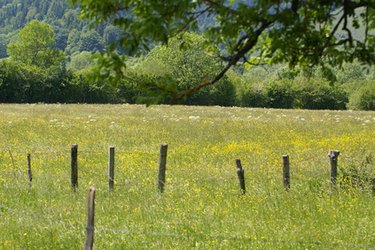
While city landscapes often contain manicured lawns and well-kept yards, pastures and fields of grass appear more natural and carefree. Field grass provides food for wildlife and livestock while guarding against soil erosion. Planting grass in large, open areas, such as fields, also discourages the growth of weeds and other undesirable ground covers. Whether you want to grow field grass for ornamental purposes or for use as feed, healthy grass requires proper planting techniques, suitable soil conditions, and adequate amounts of sunlight and moisture.
Step 1: Prepare the Soil
Remove large weeds and other types of vegetation with a tractor blade or disc attachment. Choose a day late in the early fall when the soil is slightly moist below the surface. Waiting one or two days after a rainfall allows the moisture to soak beneath the top of the soil, loosening deep roots and encouraging easy removal.
Video of the Day
Step 2: Conduct a Soil Test
Test the current health of the soil in your field. Previous vegetation, as well as occasional flooding and water runoff, can deplete your soil of necessary nutrients. Use a basic soil test to expose any soil deficiencies. Follow the instructions included with your test results to amend the soil in your field.
Step 3: Select and Purchase Field Grass
Purchase a variety of prairie or similar grass seed to plant in your field. Seed combinations provide an array of grass varieties, helping to establish an attractive, lush field of grass. Choose grass varieties that match your climate, soil and moisture conditions. Select a premixed product or mix your own with varieties like switchgrass (Panicum virgatum, USDA zone 3-9), blue grama (Bouteloua gracilis, USDA zones 3-10), buffalo (Buchloe dactyloides, USDA zones 4-7), and little bluestem (Schizachyrium scoparium, USDA zones 3-9).
Step 4: Sow Grass Seeds
Spread the seeds over the surface of your topsoil on a calm day. Use a seed broadcaster, evenly scattering the seeds over your field. Apply your seeds at the rate directed on the bags or containers. Allow the seeds to rest over the winter months.
Step 5: Monitor Field for Seed Germination
Look for sprouting seeds in the spring. In most U.S. climates melting snow and spring rains supply the necessary moisture for germination and growth. Unlike lawn grasses, field grass doesn't require supplemental watering or regular mowing. Allow your field grass to grow and produce seeds to encourage thick growth.
Step 6: Control Weed Growth
Apply an herbicide if you notice large amounts of weeds growing in your field of grass. Aggressive weeds, such as field bindweed (Convolvulus arvensis, USDA zones 2-10), can take over areas of your field.
Eliminate these weeds with a product that contains picloram or dicamba. Apply about half a pound of picloram for every acre of field grass once the weeds reach about a foot in height. Use 4 to 8 pounds of dicamba per acre for this same purpose. Wait at least a month after treatment before allowing livestock to graze the area.
Things You'll Need
Tractor with blade or disc
Soil test kit
Grass seeds
Seed broadcaster
Herbicide
Video of the Day